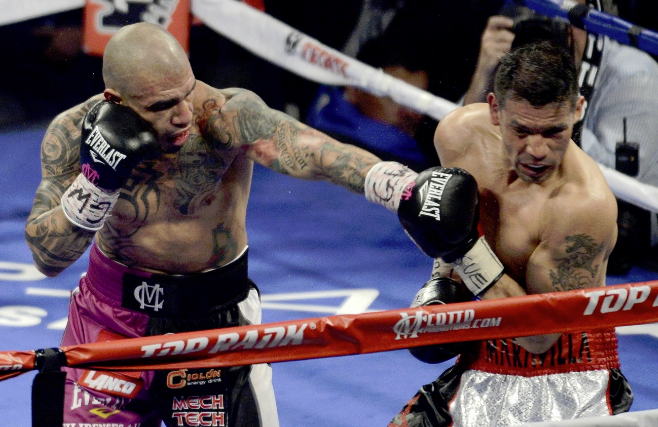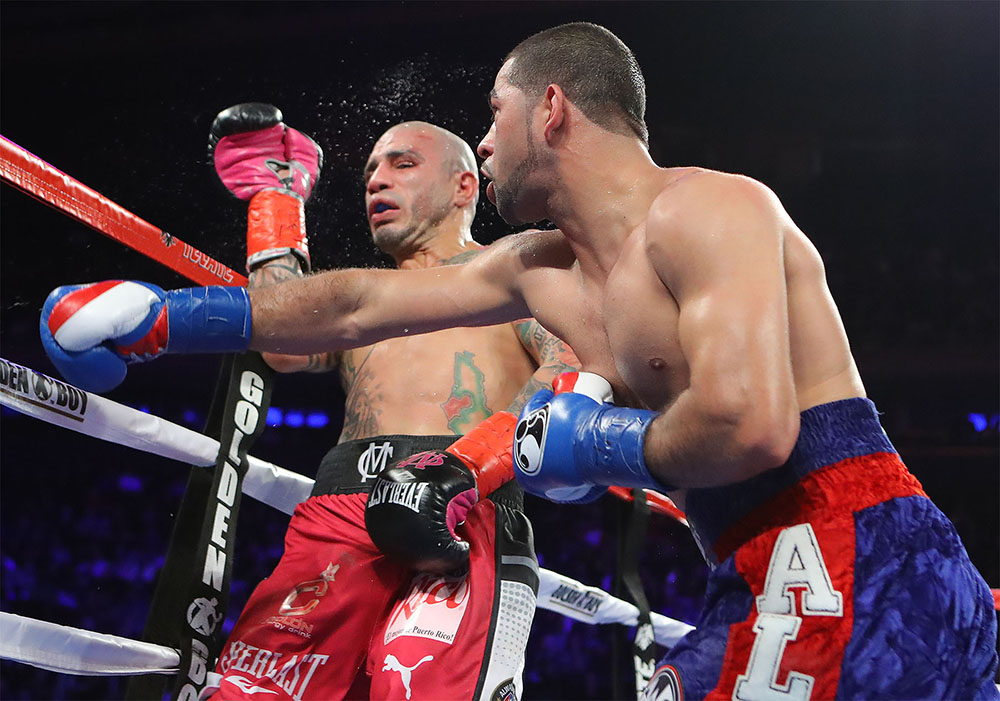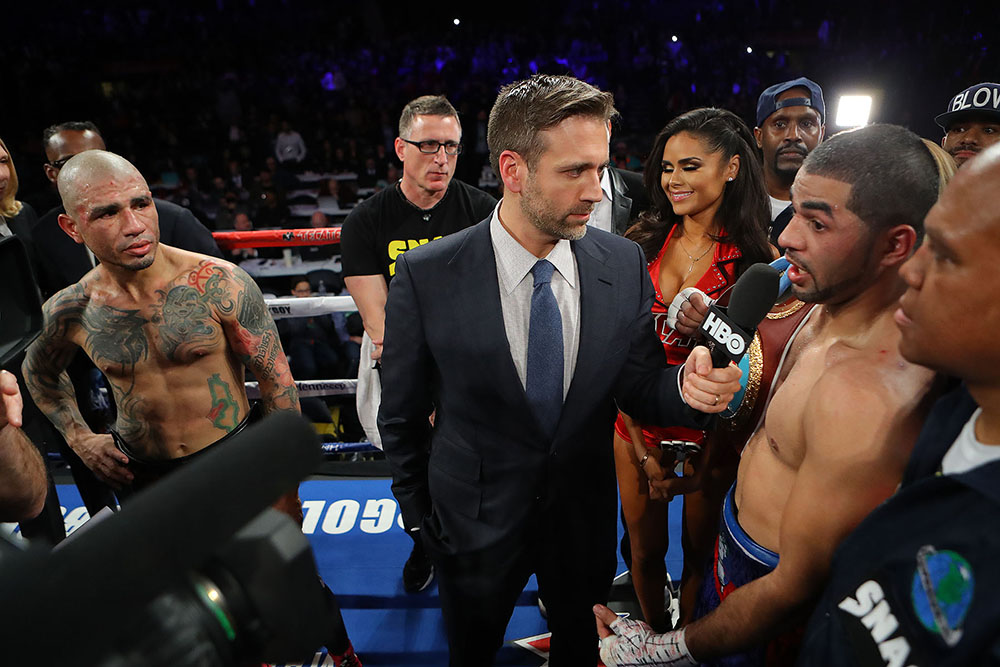Miguel Cotto’s Last Fight: A Star Says Goodbye

On Saturday, December 2 at 7:15 p.m., Miguel Cotto walked into a dressing room at Madison Square Garden preparatory to fighting for the last time.
Cotto had a lot on his mind. Nine weeks earlier, his Puerto Rican homeland had been devastated by a historic hurricane that shattered the island’s infrastructure and killed as many as 500 people. And more relevant to the hours ahead, the 37-year-old fighter had pledged that this would be his final fight.
The dressing room was a large oval enclosure that houses the New York Rangers on game nights. Locker stalls with a plaque bearing the name and uniform number of each player ringed the room. Rolls of tape lay scattered about, a reminder of the team’s 5-to-1 victory over the Carolina Hurricanes the night before. Two large sliding doors on a credenza at the far end of the room also functioned as blackboards with a red-and-blue diagram of a hockey rink emblazoned against a white backdrop on each one. Several erasable marker pens lay on a shelf behind the doors.
Cotto was wearing black pants, a burgundy jacket over a white T-shirt, and blue track shoes. His mother, wife, two sons, one of his two daughters, trainer Freddie Roach, assistant trainer Marvin Somodio, cutman David Martinez, strength and conditioning coach Gavin MacMillan, and Bryan Perez (his closest friend) were with him.
Miguel checked his email, put on some music, and sat down on one of two brown leather sofas that had been placed on opposite sides of the room. Over the next 45 minutes, he texted, talked intermittently with Perez, and ate half of a large container of fruit salad. That left Roach with time to reflect on his six-fight tenure with Cotto.
“I’m glad Miguel is retiring on his terms,” Freddie said. “That it’s not some commission saying, ‘You’re all washed up, you’re done.’ I wish more fighters made decisions like that. I know I couldn’t do it. I fought five times after I should have quit and lost four of them. The last fight I had was in Lowell, Massachusetts, which was my favorite place to fight. I embarrassed myself. I didn’t even try to win. After that, I knew it was time.”
In 2009, Roach trained Manny Pacquiao for his brutal demolition of Cotto. Did he feel badly about that, given his fondness for Miguel today?
“No,” Freddie answered. “That was my job then. But I’m on Miguel’s side now.“
Roach paused.
“You know, Miguel and Manny are the two most talented fighters I’ve had. A trainer is lucky if one fighter like that comes his way in a lifetime. I’ve had two of them. But this is a must-win fight for Miguel. After everything he’s accomplished, he doesn’t want to go out on a loss.”
At 8:00 p.m., Cotto left the dressing room and accompanied his family to their seats inside the main arena. After returning, he chatted with Golden Boy matchmaker Robert Diaz and Cotto Promotions vice president Hector Soto before leaving again, this time with New York State Athletic Commission inspector Joe Schaffer for his pre-fight physical examination and to give a urine sample. He returned at 8:40, took off his pants, put on his boxing shoes, and handed his watch and necklace to Bryan Perez for safekeeping. Then he opened a sealed bottle of Fiji water he’d brought with him and began eating the rest of his fruit salad.
NYSAC inspector Ernie Morales informed him that was a problem. If Miguel ate anything more now, he’d have to provide another urine sample. And under NYSAC rules, he could only drink water provided by the promotion which, in this case, consisted of 24 bottles of Dasani on a table at the far end of the room.
“But I like Fiji,” Miguel protested. “Water is water.”
Morales held firm.
Robert Diaz dispatched someone from Golden Boy to buy ten bottles of Fiji water for Cotto and ten more for Sadam Ali (Miguel’s opponent) so each camp would be treated equally.
Roach went down the hall to watch Ali’s hands being wrapped.
Miguel turned his attention to a large television monitor and stretched while watching an early preliminary fight.
The ten bottles of Fiji water arrived.
Andre Rozier (Ali’s trainer) came into the room and watched as Somodio taped Miguel’s hands. When the wrapping was done, Cotto lay down on the blue-carpeted floor and Marvin stretched him out. Then Miguel put on his protective cup and trunks, shadowboxed for a while, and circled the room offering a kind word and physical gesture to everyone there.
Oscar De La Hoya, Golden Boy president Eric Gomez, and director of publicity Ramiro Gonzalez came in to wish Miguel well. They were followed by referee Charlie Fitch, who gave Cotto his pre-fight instructions.
There was more shadowboxing.
Shortly after 10:00 p.m., Miguel went into an adjacent room with Perez and Soto for a brief prayer.
Somodio gloved him up.
More shadowboxing.
Cotto hit the pads with Roach for five minutes, took a minute off, and did it for five minutes more.
Another break . . . More padwork.
Rey Vargas vs. Oscar Negrete (the co-featured fight of the evening) ended.
Miguel put on his robe, left the room, and walked to a boxing ring as an active professional fighter for the 47th time.
*
Miguel Cotto was touted as boxing royalty from early in his pro career. After turning pro in 2001, he moved quickly through the 140-pound ranks with victories over Cesar Bazan, Carlos Maussa, Victoriana Sosa, and Lovemore N’Dou before capturing the WBO crown with a 2004 knockout of Kelson Pinto. A run of successful title defenses and a move up to 147 pounds followed. There were WBA title-fight victories over Carlos Quintana, Zab Judah, Shane Mosley, and others. All that changed on July 26, 2008, when Cotto fought Antonio Margarito and suffered a brutal eleventh-round knockout defeat in a bout in which Margarito’s handwraps are now widely believed to have been loaded.
Miguel was never the same fighter again. He was badly beaten by Manny Pacquiao and outslicked by Floyd Mayweather and Austin Trout. As Paulie Malignaggi (who Miguel brutalized in 2006) later observed, “There’s always a point in a fighter’s career when he starts to lose the ferocity. Every fighter loses that ferocity little by little. You either make too much money or you get a little older and start to not have as much desire.”
That seemed to be Cotto’s fate. Then Miguel claimed the WBC middleweight title and RING championship by stopping a physically compromised Sergio Martinez and followed with an impressive fourth-round knockout of Daniel Geale. A loss by decision to a younger, stronger Canelo Alvarez and a decision victory over Yoshihiro Kamegai for a vacant 154-pound WBO belt brought his career to Sadam Ali.
Cotto was at his best when he fought at 140 or 147 pounds, weights at which he was able to impose his size and physical strength on opponents.
Meanwhile, Ali was following a less glamorous path. The 2008 Olympian, now 29 years old, had been unable to rise to the top as a pro. The biggest win on his pro ledger was a 2014 stoppage of Luis Carlos Abregu that looks less impressive today in light of the fact that Abregu has had only one fight since then and lost it by knockout to a 10-and-8 journeyman opponent.
Last year, Ali stepped up in class to fight Jessie Vargas for the vacant WBO welterweight title and was stopped in the ninth round. Cotto-Ali would be Sadam’s first fight at a contract weight of 154 pounds. The contest was for the WBO 154-pound title, but the belt was largely irrelevant to the pre-fight promotion.
The storyline was simple: “This is Miguel Cotto’s last fight.”
Ali, an 8-to-1 underdog, had been chosen as the opponent on the assumption that he lacked the essentials to pose a serious threat. It would be better to see Cotto go out on a win against a lesser fighter than to leave boxing in the manner of so many great champions who lost badly in the final fight of their ring career.
Sadam himself acknowledged during a November 15, 2017, teleconference call that it was “a little scary” to be fighting “a legend who I grew up watching.”
Cotto-Ali was Miguel’s tenth fight at Madison Square Garden. Ticket sales were hurt by an attractive slate of televised college football conference championship games. More significantly, the core of Miguel’s fan base in New York is the city’s Puerto Rican community. And many would-be ticket buyers in that demographic are sending whatever discretionary income they have to relatives on the island who were hard hit by Hurricane Maria.
Still, a better-than-expected walk-up sale coupled with promotional giveaways lifted fight night attendance to 12,391.
Cotto had weighed in for the bout at 151.6 pounds, his lowest weight since fighting Manny Pacquiao in 2009. Ali weighed in at 153, his highest weight ever.
Once the bell for round one sounds, there’s no room for sentiment in a boxing ring.
In the early going, Ali’s handspeed and elusive footwork gave Cotto more than a bit of trouble. Sadam had come to win and was getting off first, while Miguel moved methodically forward but was unable to land effectively.
Cotto was also having difficulty getting out of the way of punches, which happens to fighters when they get old. A sharp right to the ear followed by a right to the temple wobbled Miguel in round two.
Then Cotto began using his jab effectively and landing hooks to the body. By round six, Ali was tiring. There was swelling around his right eye. And Miguel’s bodywork was taking a toll.
One moment can change everything in boxing.
Early in the second half of the fight, most likely in round seven or eight, Cotto tore a tendon in his left biceps.
As Bart Barry wrote long ago, “There’s the pain of torn flesh or cramped muscles or wheezing breathlessness. And then there’s injury. Injury is a non-negotiable signal sent to the central nervous system. One doesn’t make his living in athletics without knowing the difference.”
The torn tendon was an injury. It caused acute pain and rendered Cotto unable to effectively jab or hook. After eight rounds, Miguel was leading on two of the judges’ scorecards and was even on the third. But he was now a one-armed fighter.
Ali continued to fight a disciplined fight, following the formula of getting off first and not waiting for a receipt. As Sadam’s confidence grew, he fought more aggressively and won the last four rounds on each of the judges’ scorecards.
Referee Charlie Fitch did a good job of overseeing the bout. And the judges got it right: 116-112, 115-113, 115-113 in Ali’s favor.
Sadam might have been a “safe” opponent. But Father Time isn’t.
It wasn’t supposed to end this way. But boxing is rarely about happy endings.
Cotto was in obvious pain in his dressing room after the fight.
New York State Athletic Commission chief medical officer Dr. Nitin Sethi and Dr. Kevin Wright (an orthopedic surgeon) examined Miguel’s left arm and confirmed that he’d suffered a torn tendon in his left biceps. Worse, the tendon had been torn away from the bone. At their suggestion, Miguel agreed to visit the emergency room at Weill Cornell Medicine that night to see if urgent care was needed to stabilize his condition before the surgery that will follow.
It was hard to separate the injury from the outcome of the fight.
“Sadam caught Miguel with a good right hand in the second round,” Roach acknowledged. “He was more explosive than I thought he’d be. But Miguel’s jab was working well and he was doing good bodywork with the hook until he tore his biceps. He came back to the corner with a look on his face like he was in pain. I asked what was wrong, and he told me his arm was killing him. I’ve see that injury before. It takes your power away. And it hurts like hell.”
Meanwhile, Cotto was philosophical about the night’s events.
“This was the last chapter of my book on boxing,” he said. “Now I have another book to write that will be more about my family.”
Bryan Perez was asked if Miguel would miss boxing now that his career as an active fighter is over.
“I don’t think so,” Bryan answered. “For a while now, boxing has been a job as much as a passion for Miguel. It’s his work. And it’s hard work.”
Andreas Hale recently summed up Cotto’s sojourn through boxing with the thought, “Cotto may not have a pristine record like Floyd Mayweather or have rumbled through weight classes like Manny Pacquiao. But he never backed down from an opponent no matter their age, size or strength. You’ll be hard pressed to find another fighter who faced peak level opposition like Cotto did. He never waited for the ‘right time’ to take on an opponent because anytime was the right time. Take a look at his resume for proof. If you wanted to fight Miguel Cotto, Miguel Cotto wanted to fight you. He has given fight fans everything he had and then some.”
Cotto’s legacy as a fighter is that of a warrior who carried himself with dignity and grace in and out of the ring. His motto was simple: “I do my best every time I fight.”
One can argue that there’s nothing noble about one man trying to render another man unconscious by inflicting concussive blows to the brain. But Miguel Cotto has ennobled boxing.
*
Thomas Hauser can be reached by email at [email protected]. His most recent book – There Will Always Be Boxing – was published by the University of Arkansas Press. In 2004, the Boxing Writers Association of America honored Hauser with the Nat Fleischer Award for career excellence in boxing journalism.



















